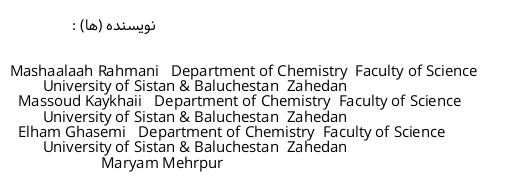مقاله Application of narrow-bore tube / dispersive liquid–liquid microextraction for extraction of BTEX from juice samples before their GC/FID determination
توجه : به همراه فایل word این محصول فایل پاورپوینت (PowerPoint) و اسلاید های آن به صورت هدیه ارائه خواهد شد
مقاله Application of narrow-bore tube / dispersive liquid–liquid microextraction for extraction of BTEX from juice samples before their GC/FID determination دارای ۶ صفحه می باشد و دارای تنظیمات در microsoft word می باشد و آماده پرینت یا چاپ است
فایل ورد مقاله Application of narrow-bore tube / dispersive liquid–liquid microextraction for extraction of BTEX from juice samples before their GC/FID determination کاملا فرمت بندی و تنظیم شده در استاندارد دانشگاه و مراکز دولتی می باشد.
توجه : در صورت مشاهده بهم ریختگی احتمالی در متون زیر ،دلیل ان کپی کردن این مطالب از داخل فایل ورد می باشد و در فایل اصلی مقاله Application of narrow-bore tube / dispersive liquid–liquid microextraction for extraction of BTEX from juice samples before their GC/FID determination،به هیچ وجه بهم ریختگی وجود ندارد
بخشی از متن مقاله Application of narrow-bore tube / dispersive liquid–liquid microextraction for extraction of BTEX from juice samples before their GC/FID determination :
تعداد صفحات:۶
چکیده:
A new simple and effective method based on dispersive liquid–liquid microextraction (DLLME) procedure is proposed for rapid and simultaneous separation andpreconcentration of ultra trace amounts of benzene, toluene, ethylbenzene and xylene (BTEX) in juice samples. The DLLME method was performed in a narrow-bore tubecontaining aqueous sample. This simple configuration avoids the centrifugation step, which is time consumingstep in the extraction and permits a solvent with a density lighter than water to be used as extraction solvent and therefore expands the applicability of DLLME to a widerrange of solvents. The influence of extraction parameters, such as kind and volume of extraction and disperser solvents, volume of sample, temperature and pH of the solution and its ionic strength were investigated and optimized. The best efficiency of extraction acquired usingacetone and nonanol as dispersive and extraction solvents respectively. Under the optimum condition, the proposedmethod provided a wide linear range (6–۷۰۰ g.L1) withcorrelation coefficient (R2) of 0.96, reproducibility (asRSD) better than 4.5% (n= 5) and relative recovery of 96.2- 101.0%. The limit of detection (S/N=3) and enrichment factor were in the range of 1.5–۲۲ g.L1 and 31–۱۷۳ times, respectively. At the end, the DLLME-GC–FID method was successfully applied for the determination of BTEX compounds in a few real juice samples.

- در صورتی که به هر دلیلی موفق به دانلود فایل مورد نظر نشدید با ما تماس بگیرید.
 دانش رسان |
مرکز علم و دانش کشور
دانش رسان |
مرکز علم و دانش کشور 

